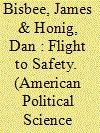| Srl | Item |
| 1 |
ID:
184293


|
|
|
|
|
| Summary/Abstract |
The relationship between anxiety and investor behavior is well known enough to warrant its own aphorism: a “flight to safety.” We posit that anxiety alters the intensity of voters’ preference for the status quo, inducing a political flight to safety toward establishment candidates. Leveraging the outbreak of the novel coronavirus during the Democratic primary election of 2020, we identify a causal effect of the outbreak on voting, with Biden benefiting between 7 and 15 percentage points at Sanders’s expense. A survey experiment in which participants exposed to an anxiety-inducing prompt choose the less disruptive hypothetical candidate provides further evidence of our theorized flight to safety among US-based respondents. Evidence from 2020 French municipal and US House primary elections suggests a COVID-induced flight to safety generalizes to benefit mainstream candidates across a variety of settings. Our findings suggest an as-yet underappreciated preference for “safe” candidates in times of anxiety.
|
|
|
|
|
|
|
|
|
|
|
|
|
|
|
|
| 2 |
ID:
124977


|
|
|
|
|
| Publication |
2013.
|
| Summary/Abstract |
In this paper, we study strategic asset allocation for China's foreign reserves using a risk-based approach. Four aspects of the risk management are investigated: an investment universe, dependence structure, allocation strategies under risk minimization and trade-off between risks and returns. A regime-switching copula model is developed to investigate the dynamic dependence between assets. One regime emphasizes a short-term safe asset and the other regime emphasizes a long-term safe asset. The optimal allocation is derived following two strategies: risk minimization and trade-off between risks and returns in utility maximization with disappointment avoidance. If the central bank focuses solely on risk minimization, the asymmetries in the asset return dependence encourage the flight to safety. However, if higher risks are allowed in exchange for higher returns, even the exchange is very conservative, and the asymmetries would discourage the flight to safety. Therefore, we suggest that China should mitigate its flight to safety after 2008 and increase holdings of short-term bank deposits, long-term treasury bonds and euro bonds.
|
|
|
|
|
|
|
|
|
|
|
|
|
|
|
|